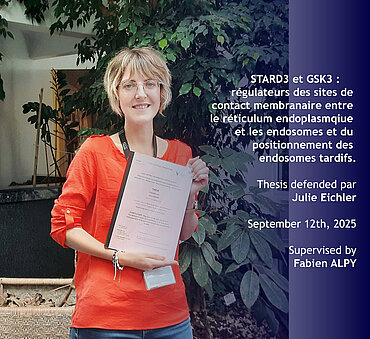Congratulations to Julie EICHLER on the acceptance of her thesis!
Her work, supervised by Dr. Fabien Alpy,
is entitled: “STARD3 and GSK3: Regulators of Membrane Contact Sites between the Endoplasmic Reticulum and Endosomes, and of Late Endosome Positioning.”

Summary of Research Work
The protein STARD3 is overexpressed in HER2+ breast cancers and contributes to their growth. This modular protein comprises a MENTAL domain that anchors it to late endosomes/lysosomes (LE/Lys), a Phospho-FFAT motif, and a START domain involved in cholesterol transport.Phosphorylation of STARD3’s Phospho-FFAT motif activates its interaction with the MSP domain of VAP proteins (VAPA, VAPB, and MOSPD2) located in the endoplasmic reticulum (ER), thereby enabling the formation of ER–LE/Lys membrane contact sites (MCSs).The kinase GSK3 is responsible for this phosphorylation and regulates the interaction between STARD3 and VAP proteins, as well as the formation of ER–LE/Lys MCSs. In the absence of phosphorylation, LE/Lys aggregate in the perinuclear region.This phenotype also depends on the START domain, for which we identified a new function: it can interact with negatively charged membranes and is responsible for the clustering of STARD3-positive LE/Lys when STARD3 is not engaged in ER–LE/Lys contact sites.Thus, STARD3 phosphorylation by GSK3 controls both MCS formation and LE/Lys positioning.
Keywords: Membrane contact sites, Endoplasmic reticulum, Late endosomes/lysosomes, GSK3, STARD3, Phospho-FFAT motif
Skills Acquired at the IGBMC
During these four years of doctoral research, I acquired strong technical skills in molecular and cell biology.
Beyond the scientific aspects, this experience also enabled me to develop project management and coordination, data analysis, and communication skills, through the writing of publications and participation in numerous conferences.
I also learned the importance of knowledge sharing, particularly through the training of interns and students during my teaching duties at the Faculty of Life Sciences.
Finally, this PhD strengthened my team spirit and curiosity, allowing me to take part in multiple projects, address complex scientific questions, and explore new research topics.
Life at the IGBMC
What I appreciated most at the IGBMC was the richness of the technological platforms and the expertise of the teams that make them thrive.
My project relied heavily on fluorescence microscopy, which led to close collaboration with the Photon Microscopy Platform.
I would like to especially thank Erwan Grangirard and Elvire Guiot for their availability and kindness.
Other services also play a key role in enabling us to work efficiently — such as the PluriCell East Cell Culture Facility and the MediaPrep Service, where Denis Fumagalli does remarkable work and contributes to maintaining a comfortable and serene research environment.
Collaborations
My PhD project was largely the result of multidisciplinary collaborations.
We had the opportunity to benefit from Catherine Birck’s expertise for analytical ultracentrifugation experiments, Alastair McEwen’s input on structural biology, and Victor Hanss’s contribution to FIB-SEM imaging and 3D reconstruction.
We also collaborated with Guillaume Drin and Ana Cardinal from the IPMC, whose contributions were invaluable for certain in vitro experiments.
Funding and Partners
My PhD was funded by the IMCBio PhD Program for the first three years, and by the Ligue contre le cancer for the fourth year.
Future Projects
I now wish to move toward pharmaceutical research and discover the private sector, in order to understand how scientific advances integrate into a more industrial dynamic and translate into concrete therapeutic solutions for patients.
